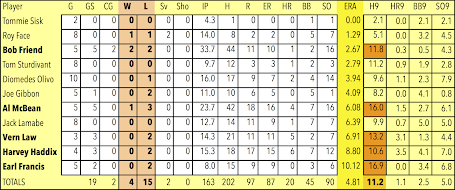And what is that nugget? Why it's the fact that the Red Sox going 8-19 (.296) in July after going 20-6 (.769) in June is one of the rarest occurrences in the entire history of major league baseball.
It turns out, in this instance, that the "why" of it is not hard to trace; thanks to ace researcher Tom Ruane (of Retrosheet fame), however, we know that you can count on the fingers of one hand the teams who have followed the exact sequence described above.
The 2022 Red Sox have joined the following teams in having a searingly hot month followed by a hot mess of a month. Here they are, going backward in time:
--2006 Atlanta Braves (May: 18-11, .621; June: 6-21, .222)
--1987 Baltimore Orioles (May: 17-11, .607; June: 5-23, .179)
--1966 Cincinnati Reds (August: 18-12, .600; September: 7-17, .292)
--1933 Cleveland Indians (August, 19-11, .633; September, 7-12, .368)
And that, folks, is that. Only four other teams with a .600+ month followed by a -.400 month. While players' stats can fluctuate wildly from month-to-month, it turns out that team records just don't swing with the same, er, "swinginess." (Note, though, that the Sox' "swing" between months is a good bit more extreme than these teams...)
We hope that Tom will look at the opposite phenomenon at some point: the team with a really bad month that's followed by a really good month. Turns out that the 1987 O's are going to be on that list as well: after they went 5-23 in June, they followed that up with a 16-10 July (.615). On top of that, in September they plummeted back to 6-21 (.222)! As Jayson Stark would say if he were here (and who's to say he isn't?)--baseball!
One team that we know fits into the opposite variation: the 2001 Oakland A's (8-17 in April, 18-9 in May). Unlike the four teams who did the "good-bad" instead of the "bad-good," they wound up having an excellent season (102-60). The four "good-bad" teams all wound up around .500.
We'll use our semi-patented "GvB" method on the '22 Red Sox. (GvB is our shorthand for looking at quality of opposition, dualized into .500+ and <.500 teams. These can be rather fluid throughout the year, as some teams cross back and forth over the .500 mark, but as our dear old Dad used to say, you've got to take what you can get.
And what we get from the Red Sox' detailed GvB chart thus far for '22 (at right) is that they are playing a helluva lotta good teams this year. In fact, they've played the most of these (76 out of their first 103 games) than any other team in MLB this year. That's got to affect your overall winning percentage right there...What will (eventually) leap out at you in the GvB breakout is that in June, the Sox finally got to play the lesser-lights on their schedule. They mopped the floor with those guys (12-2 in June). With veterans Rich Hill and Michael Wacha joining Nick Pivetta and Nathan Eovaldi, Boston's starting rotation had its best month since 2018 during June.
But Pivetta and Eovaldi backslid in July against tougher competition (24 of 27 games against good teams) and both Hill and Wacha landed on the DL for the entire month. The records of the starting pitchers in the two months tell the tale (dare we say...Starkly?): 16-4, 2.91 in June, 1-13, 7.09 in July.
The Red Sox actually did their best hitting of the '22 season in May; June was a downturn. But with the pitching going gangbusters against generally easier competition, that mattered not at all. In July, however, they stopped hitting as well (.238 BA, 3.4 runs/game). And Rafael Devers, their best hitter, was injured and missed 11 games.
As noted, the reasons why it happened make perfect sense. It's just odd (and very rare) that it happened in back-to-back months. (Cue Jayson again...)
What does it look like for the rest of the season? Let's just take it one month at a time. August will still have at least 17 and maybe up to 23 games where the Sox will face good teams. However, Devers and Hill and Wacha are due back soon--and that can't hurt. But the history of the other four teams who had this pattern suggests that they'll probably wind up as around a .500 team for the season. Stay tuned...






































